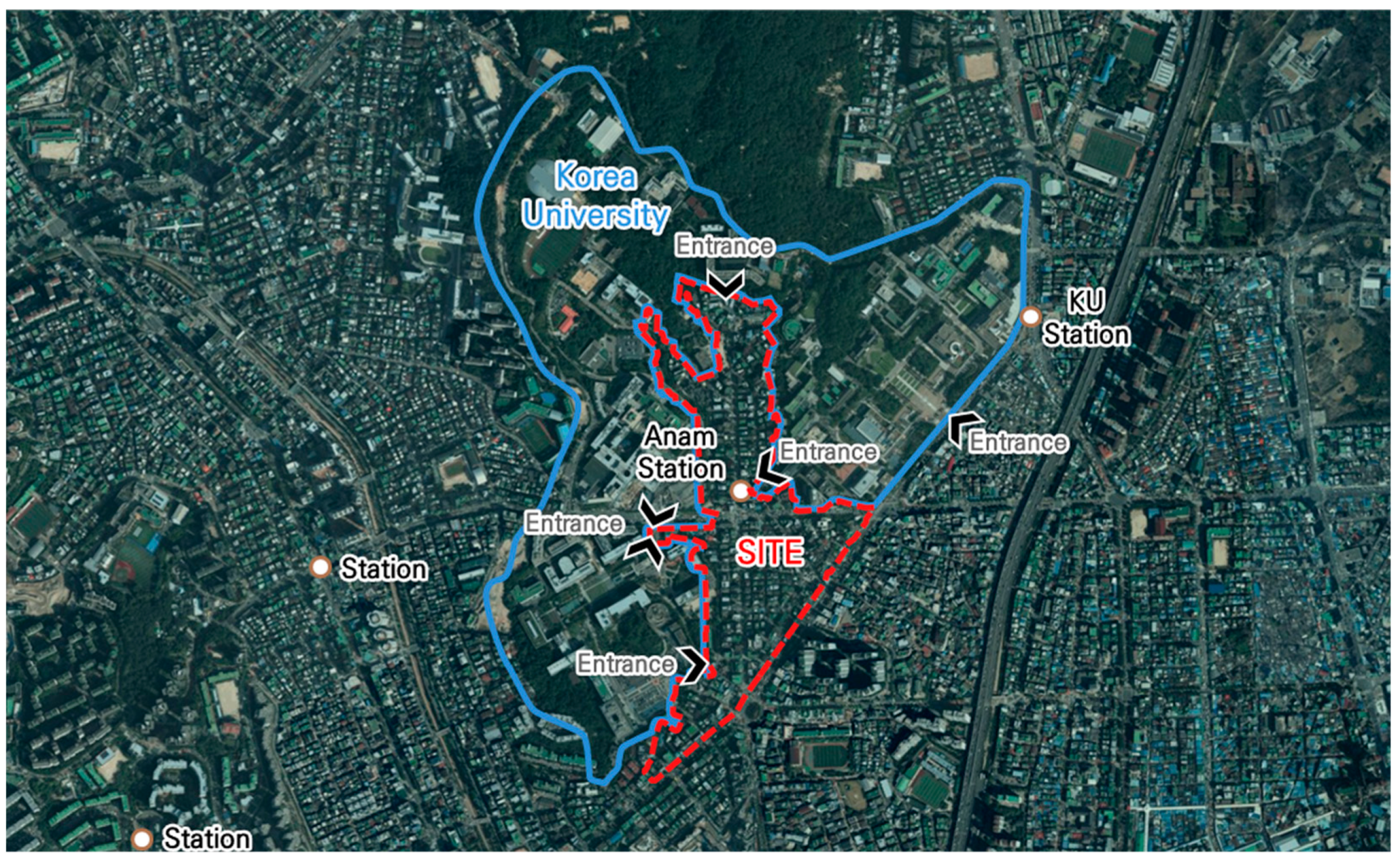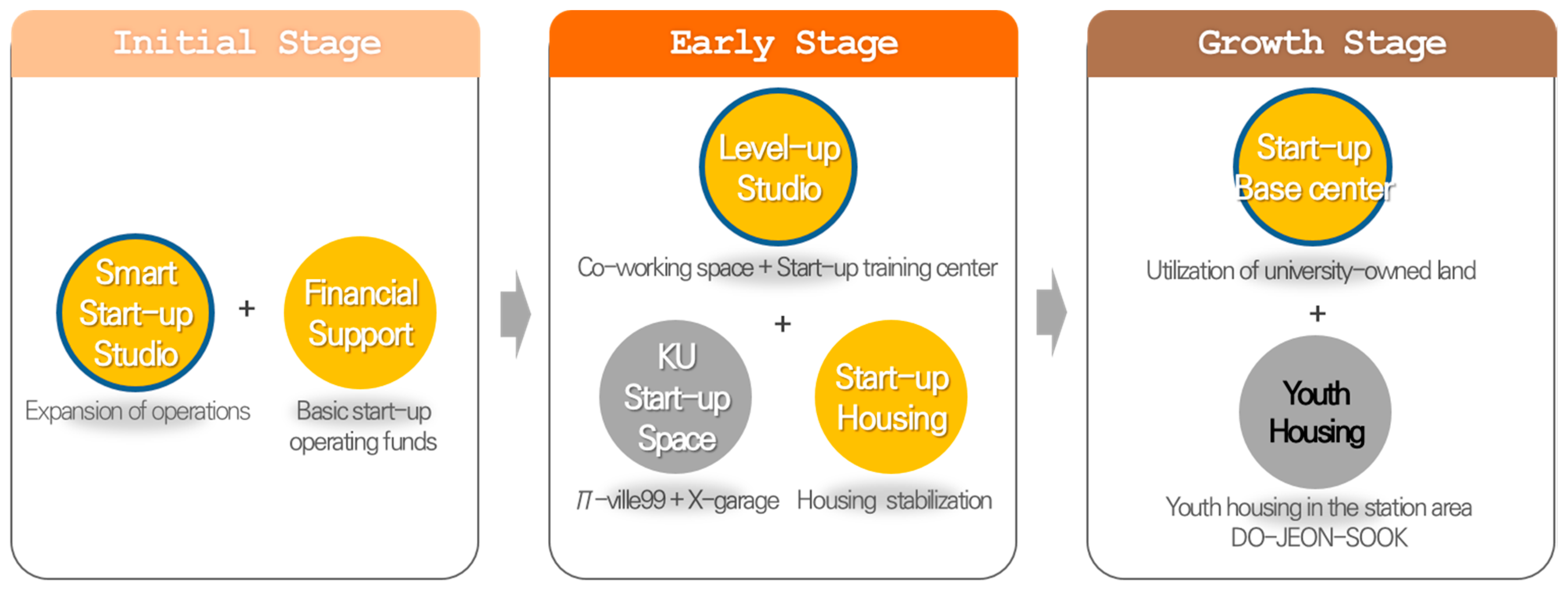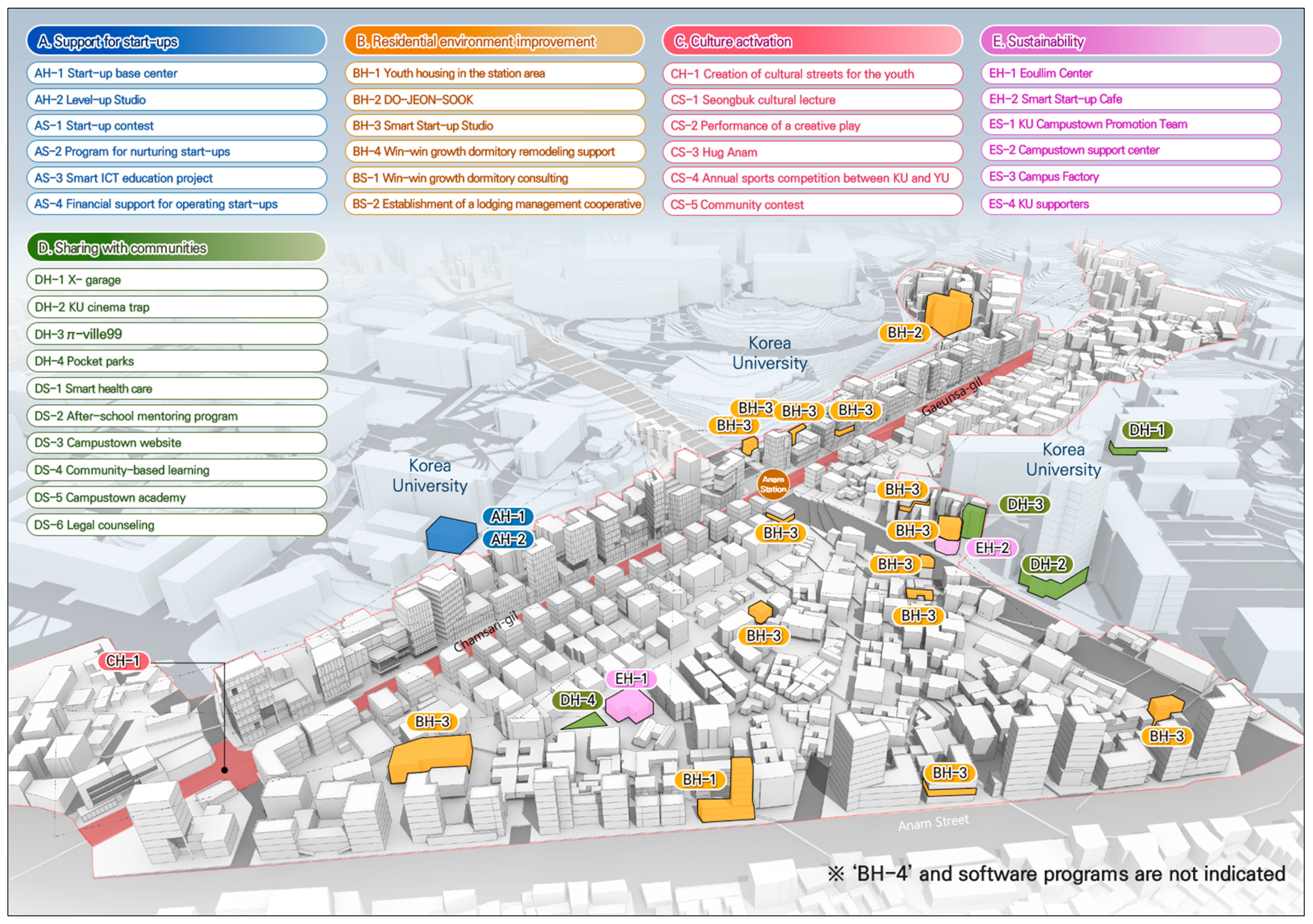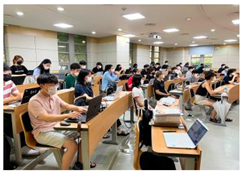Study of Campustown Projects for the Sustainable Win-Win Growth of Universities and Communities
Abstract
1. Introduction
1.1. Background and Purpose of the Study
1.2. Related Research on Campustown
1.3. Distinctiveness of This Study
2. Theoretical Research and Current Status of Campustown Projects in Seoul
2.1. Concept of Campustowns
2.2. Master Plan for Campustown Projects in Seoul
2.3. Basic Plan of the KUACP
3. Materials and Methods
3.1. Definition of Terms
3.2. Scope and Methodology of the Study
4. Results
4.1. Literature Review
4.1.1. Overseas Research
4.1.2. Domestic Research
| Category | Reference | Indicators Related to Campustown Win-Win Plans | |
|---|---|---|---|
| Overseas research | [26] |
|
|
| [27] |
|
| |
| [29] |
|
| |
| [30] |
|
| |
| Domestic research | [31] |
| |
| [14] |
|
| |
| [32] |
|
| |
| [22] |
|
| |
| [23] |
|
| |
4.2. Case Studies
4.3. Application of the Primary Indicators to Target Areas
4.3.1. Status of the Target Site and SWOT Analysis
- (1)
- Population composition status
- (2)
- Socioeconomic status
- (3)
- Cultural characteristics
- (4)
- Physical status
- (5)
- The strengths of Korea University related to community contribution
4.3.2. Collection of Stakeholders’ Opinions
4.3.3. In-Depth Interviews with Experts
4.4. Commercialization Review of Indicators
4.5. Ensuring the Project Implementation Capacity to Improve Sustainability
4.5.1. Establishment of Systems for Supporting Start-Ups
4.5.2. Establishment of Cycles for Improved Sustainability
4.5.3. Establishment of a Collaborative Model for Improving Residential Environments
4.5.4. Creation of a Cultural Hub for Better Community Relations
4.5.5. Sharing with Communities and Improved Sustainability
5. Discussion
6. Conclusions
Author Contributions
Funding
Institutional Review Board Statement
Informed Consent Statement
Data Availability Statement
Acknowledgments
Conflicts of Interest
References
- Jang, Y.K. University-based urban regeneration through campustown in Seoul. Architecture 2018, 62, 11–13. [Google Scholar]
- Hong, M.Y. Campustown strategic plan. Architecture 2018, 62, 14–20. [Google Scholar]
- Kim, J.E. A case study of neighborhood renewal through university-community partnership: UID Neighborhood Initiative. Seoul Stud. 2010, 11, 69–86. [Google Scholar]
- Yu, J.D. A Study on Construction of Development Model for Campus Town Activation. Ph.D. Thesis, Hongik University, Seoul, Republic of Korea, 2013. [Google Scholar]
- An, H.J.; Lee, S.H. Creating shared value (CSV) between a start-up and the community: Focusing on the activities of the campus town local project at K University. J. Korean Entrep. Soc. 2022, 17, 255–281. [Google Scholar]
- Sul, W.S. Utilizing university resources for community development: Focused on the campus town project of Sookmyung Women’s University. Korean Manag. Consult. Rev. 2018, 18, 281–291. [Google Scholar]
- Chu, H.S.; Baek, T.Y.; Kang, J.M. Review of the physical evaluation factors of the campustown project (focused on Seoul campustown project). KSCE J. Civ. Environ. Eng. Res. 2018, 38, 149–157. [Google Scholar]
- Kong, J.S.; Lee, J.H. Performance and experience of Korea University Anam campustown. Architecture 2018, 62, 21–25. [Google Scholar]
- Chun, H. Sookmyung-Youngsan cross campus based S-cultural belt creation. Architecture 2018, 62, 26–31. [Google Scholar]
- Kim, Y.O. ‘Campustown’ Planning of Sejong University. Architecture 2018, 62, 32–36. [Google Scholar]
- Bae, W.K. Chung-Ang University campustown: Young people, blue dragon soaring from the ground. Architecture 2018, 62, 37–42. [Google Scholar]
- Park, T.W. Campustown planning of KwangWoon University: Implementation strategy for start-up friendly city. Architecture 2018, 62, 43–48. [Google Scholar]
- Homepage of Seoul Campustown, Seoul Metropolitan Government. Available online: https://campustown.seoul.go.kr/ (accessed on 10 May 2021).
- Jeon, K. A Study on the Urban Regeneration Strategies through Expansion of University Campus (Focused on the Type of Community Building). Master’s Thesis, Korea University, Seoul, Republic of Korea, 2012. [Google Scholar]
- Guo, W.; Wu, D.F.; Li, Y.; Wang, F.X.; Ye, Y.Q.; Lin, H.W.; Zhang, C.F. Suitability evaluation of popular science tourism sites in university towns: Case study of Guangzhou University Town. Sustainability 2022, 14, 2296. [Google Scholar] [CrossRef]
- Dalton, L.C.; Hajrasouliha, A.H.; Riggs, W.W. State of the art in planning for college and university campuses: Site planning and beyond. J. Am. Plan. Asoc. 2018, 84, 145–161. [Google Scholar] [CrossRef]
- Abdul-Rahman, M.; Adegoriola, M.I.; McWilson, W.K.; Soyinka, O.; Adenle, Y.A. Novel use of social media big data and artificial intelligence for community resilience assessment (CRA) in university towns. Sustainability 2023, 15, 1295. [Google Scholar] [CrossRef]
- Li, S.; Qu, F. Preserving authenticity in urban regeneration: A framework for the new definition from the perspective of multi-subject stakeholders (a case study of Nantou in Shenzhen, China). Int. J. Environ. Res. Public Health 2022, 19, 9135. [Google Scholar] [CrossRef] [PubMed]
- Mennel, T. The city as campus: Urbanism and higher education in Chicago. Plan. Perspect. 2012, 27, 156–158. [Google Scholar]
- Kou, H.; Zhang, S.; Liu, Y. Community-engaged research for the promotion of healthy urban environments: A case study of community garden initiative in Shanghai, China. Int. J. Environ. Res. Public Health 2019, 16, 4145. [Google Scholar] [CrossRef]
- den Heijer, A.C.; Curvelo Magdaniel, F.T.J. Campus-City Relations: Past, Present, and Future; Meusburger, P., Heffernan, M., Suarsana, L., Eds.; Geographies of the University; Springer International Publishing: Berlin/Heidelberg, Germany, 2018; pp. 439–459. [Google Scholar]
- Yeo, H. University-Community Collaborative Partnership: Comparative Study of Urban Campus Planning in Korea and US. Ph.D. Thesis, Seoul National University, Seoul, Republic of Korea, 2007. [Google Scholar]
- Han, Y.O. Town Management Implementation Model as Urban Regeneration Techniques by Community Governance (Focusing on Seoul Campus Town Project). Ph.D. Thesis, Kwangwoon University, Seoul, Republic of Korea, 2018. [Google Scholar]
- Oh, J.; Kim, D.; Yeo, H.; Kim, S. Campus town planning and designing from neighborhood regeneration perspectives (focused on designating a strategic area and devising its creation plan). J. Urban Des. Inst. Korea 2014, 15, 41–59. [Google Scholar]
- Kim, J.Y.; Kim, J.H. Urban regeneration involving communication between university students and residents: A case study on the Student Village Design Project. Int. J. Environ. Res. Public Health 2022, 19, 15834. [Google Scholar] [CrossRef]
- Zhang, Y.; Zhu, H.; Mu, B.; Zhang, X.; Cui, X. Inter-campus sharable potential of hardware educational resources in a university town: Connotation, determination method and a case study. Sustainability 2020, 12, 1636. [Google Scholar] [CrossRef]
- Colding, J.; Barthel, S. The role of university campuses in reconnecting humans to the biosphere. Sustainability 2017, 9, 2349. [Google Scholar] [CrossRef]
- Ruoppila, S.; Zhao, F. The role of universities in developing China’s university towns: The case of Songjiang university town in Shanghai. Cities 2017, 69, 56–63. [Google Scholar] [CrossRef]
- Brandt, C.; De Mortanges, C.P. City branding: A brand concept map analysis of a university town. Place Brand. Public Dipl. 2011, 7, 50–63. [Google Scholar] [CrossRef]
- Mapes, J.; Kaplan, D.; Turner, V.K.; Willer, C. Building ‘College Town’: Economic redevelopment and the construction of community. Local Econ. 2017, 32, 601–616. [Google Scholar] [CrossRef]
- Ahn, K.H. A study on the campus master planning methods. J. Korean Inst. Educ. Facil. 2008, 15, 5–12. [Google Scholar]
- Baek, T.Y. A Study on the Campus Town Business Elements of Job-Centered Urban Regeneration (Based on the Seoul Campus Town Project). Master’s Thesis, Hongik University, Seoul, Republic of Korea, 2018. [Google Scholar]
- Homepage of School of Medicine, Boston University. Available online: https://www.bumc.bu.edu/citylab/about (accessed on 16 May 2021).
- Homepage of Chicago University. Available online: https://civicengagement.uchicago.edu/pillars/education (accessed on 22 May 2021).
- Haar, S. Urbanism and Higher Education in Chicago; University of Minnesota Press: Minneapolis, MN, USA, 2010; Available online: https://www.jstor.org/stable/10.5749/j.cttttb2b (accessed on 22 May 2021).
- Korean Statistical Information Service. Available online: https://kosis.kr/index/index.do (accessed on 19 July 2022).
- Homepage of Korea University. Available online: https://www.korea.ac.kr/mbshome/mbs/university/subview.do?id=university_010106000000 (accessed on 19 July 2022).
- Homepage of Korea University Research & Business Foundation. Available online: https://rms.korea.ac.kr (accessed on 19 July 2022).
- Homepage of Korea University Holdings. Available online: https://kuholdings.co.kr (accessed on 19 July 2022).
- Stanton, T.K. New Times Demand new scholarship Opportunities and challenges for civic engagement at research universities. Educ. Citizsh. Soc. Justice 2008, 3, 19–42. [Google Scholar] [CrossRef]
- Homepage of Public Announcement of University Information. Available online: https://www.academyinfo.go.kr/search/search.do (accessed on 25 October 2022).
- Rodriguez-Domenech, M.A. Medium-sized cities facing the demographic challenge in Spain’s low-density regions through citizen participation projects. Int. J. Environ. Res. Public Health 2022, 19, 5303. [Google Scholar] [CrossRef]





| Sector | Strategic Plan of the Seoul Metropolitan Government | Strategic Plan of KUACP |
|---|---|---|
| Support for start-ups | Create a job environment through a challenger center that helps people reach goals of initiating start-ups | Revitalization of the local economy through youth start-ups and job creation |
| Residential environment improvement | Housing support for the youth to reduce regional conflicts | Improvement of the residential environment in underdeveloped university districts and solutions to youth housing problems |
| Culture activation | Support for creating a youth cultural space where ideas and culture can be exchanged | Provision of spaces and programs to revitalize youth culture |
| Sharing with communities | Young people (university) support communities to create healthy college towns in the region | Ensuring sustainability by sharing university infrastructure and human resources |
| Revitalization of commercial districts | Revitalization of the local economy/promotion of the revitalization of commercial districts with universities and local merchandisers | Expansion of infrastructures for the revitalization of commercial districts within university districts |
| 1. Theoretical Research and Current Status of Campustown Projects in Seoul | ||||||
| Concept of campustowns | Setting five sectors of KUACP | |||||
| Master plan for campustown projects in Seoul | Start-ups | Residence | Culture | Sharing with communities | Commercial districts | |
| Strategic plan of KUACP | ||||||
| 2. Primary indicators of win-win growth from campustown plans | ||||||
| Literature review of studies in other countries (n = 4) | Literature review of studies in Korea (n = 5) | Case studies (n = 3) | ||||
| 3. Application of the primary indicators to target areas and commercialization plans | ||||||
| Analysis of the target-area status | SWOT analysis | Collection of stakeholders’ opinions | In-depth interviews with experts | |||
|
|
|
| |||
| Commercialization review | ||||||
| Project budget | Feasibility of the project | Administrative procedural matters | ||||
| Selection of final projects | ||||||
| Support for start-ups | Residential environment improvement | Culture activation | Sharing with communities | Sustainability | ||
| HW: 2 SW: 4 | HW: 4 SW: 2 | HW: 1 SW: 5 | HW: 4 SW: 6 | HW: 2 SW: 4 | ||
| 4. Security of project implementation capacity to improve sustainability | ||||||
| Support for start-ups |
| |||||
| Residential environment improvement |
| |||||
| Culture activation |
| |||||
| Sharing with communities |
| |||||
| Sustainability | ||||||
| City and University | Planning Year | Indicators Related to Campustown Win-Win Growth Plans | |
|---|---|---|---|
| The University of Pennsylvania, Philadelphia, USA | 1940s ~ |
|
|
| Boston University, Boston, USA | 1950s ~ |
|
|
| University of Chicago, Chicago, USA | 1950s ~ |
|
|
| Category | Support for Start-Ups | Residential Environment Improvement | Culture Activation | Sharing with Communities (Sustainability) | Revitalization of Commercial Districts |
|---|---|---|---|---|---|
| Strategic plan | Refer to [Table 1] | ||||
| Strengths |
| - |
|
|
|
| Weaknesses |
|
|
|
|
|
| Opportunities |
|
|
|
|
|
| Threats |
|
|
|
|
|
| SO strategy |
| - |
|
|
|
| ST strategy |
|
| |||
| WO strategy |
|
|
|
|
|
| WT strategy |
|
|
| ||
| Excluded indicators | A1 | D4, D5 | F1, F2, F3, F4 | ||
| Category | First Workshop | Second Workshop | Third Workshop | |
|---|---|---|---|---|
| Period | 17 August 2022 | 27 August 2022 | 3 September 2022 | |
| Location | KU SK Future Hall | KU Woodang Hall | KU start-up cafe | |
| Targets | 24 students/15 residents/ 8 merchandisers | 19 students/7 residents/ 6 merchandisers | 8 students/3 residents/ 2 merchandisers | |
| Opinions about indicators | A4 |
| ||
| B4 |
|
| - | |
| C5 |
|
|
| |
| C6 |
|
|
| |
| E1 |
| |||
| Picture |  |  |  | |
| Sectors | Participant Groups | No. of Participants | Opinions about Indicators | |
|---|---|---|---|---|
| Support for start-ups | Center for nurturing start-ups, Korea University Technology Holding Company, Korea University LG Social Campus Start-up related clubs | 8 | A2–A3 Integrated |
|
| A5 Corrected |
| |||
| Residential environment improvement | Minsnail Union Kojam Boarding house operators | 5 | B1–B2 Integrated |
|
| B4 Specified |
| |||
| Culture activation | Seongbuk Cultural Center KU cinema trap Student Club Union | 5 | C1–C2 Integrated |
|
| C3–C4 Corrected |
| |||
| Sharing with communities (Sustainability) | Institute for Continuing Education, Korea University Volunteer Corps | 5 | D1–D3 Integrated |
|
| D15 Corrected |
| |||
| E3–E4 Specified |
| |||
| Revitalization of commercial districts | Association of Chamsari-gil merchandisers Co-op of shopkeepers in Anam-dong | 5 | F5–F8 Deleted |
|
 | ||||
| Strategic Plan | Primary Indicators | a | b | c | d | Final Projects | ||||||
|---|---|---|---|---|---|---|---|---|---|---|---|---|
| a-1 | a-2 | a-3 | b-1 | b-2 | b-3 | c-1 | ||||||
| A | A1 | Young population | ○ | × | × | - | ||||||
| A2 | Job creation | ○ | ○ | ○ | ● | ▲ | ●▲ | AH-1 | Start-up base center | |||
| A3 | Support for start-ups | ○ | ○ | ● | AS-1 | Start-up contest | ||||||
| A4 | Creation of spaces for start-ups | ○ | ○ | △ | △ | AH-2 | Level-up Studio | |||||
| A5 | Training and mentoring for start-up | ○ | ○ | △ | ▲ | △▲ | AS-2 | Program for nurturing start-ups | ||||
| AS-3 | Smart ICT education project | |||||||||||
| A6 | Financial support for operating start-ups | ○ | ○ | ○ | AS-4 | Financial support for operating start-ups | ||||||
| B | B1 | Rental housing for youth | ○ | ○ | ○ | ● | ▲ | ●▲ | BH-1 | Youth housing in the station area | ||
| B2 | Security of dormitories | ○ | ○ | ● | BH-2 | DO-JEON-SOOK | ||||||
| B3 | Living Lab | ○ | ○ | △ | △ | BH-3 | Smart Start-up Studio | |||||
| B4 | Residential environment improvement for the youth | ○ | ○ | ▲ | ▲ | ▲ | BH-4 | Win-win growth dormitory remodeling support | ||||
| BS-1 | Win-win growth dormitory consulting | |||||||||||
| BS-2 | Establishment of a lodging management cooperative | |||||||||||
| C | C1 | Creation of unique streets | ○ | ○ | ● | △ | ●△ | CH-1 | Creation of cultural streets for the youth | |||
| C2 | Place making | ○ | ○ | ○ | ● | |||||||
| C3 | Arts and culture | ○ | ○ | ● | △ | ▲ | ●△▲ | CS-1 | Seongbuk cultural lecture | |||
| C4 | Cultural and art activities | ○ | ○ | ● | CS-2 | Performance of a creative play | ||||||
| C5 | Community festivals | ○ | ○ | △ | ▲ | △▲ | CS-3 | Hug Anam | ||||
| CS-4 | Annual sports competition between KU and YU | |||||||||||
| C6 | Resident participation-based cultural content | ○ | ○ | △ | △ | CS-5 | Community contest | |||||
| D | D1 | Hardware educational resources | ○ | ○ | ○ | ○ | ● | ▲ | ●▲ | DH-1 | X-garage | |
| D2 | Opening university facilities to the public | ○ | ○ | ○ | ● | DH-2 | KU cinema trap | |||||
| D3 | CityLab | ○ | ○ | ● | DH-3 | π-ville99 | ||||||
| D4 | Investment in infrastructure | ○ | × | × | - | |||||||
| D5 | Improvement of physical accessibility | ○ | × | × | - | |||||||
| D6 | Improvements in street environments in communities | ○ | ○ | ● | ● | Integrated into ‘CH-1’ | ||||||
| D7 | University City Brite | ○ | ○ | ● | ||||||||
| D8 | Security of open spaces | ○ | ○ | ● | ●△ | DH-4 | Pocket parks | |||||
| D9 | Creation of green infrastructure networks | ○ | ○ | ● | ||||||||
| D10 | University City Green | ○ | ○ | ● | ||||||||
| D11 | Health support program | ○ | ○ | ○ | DS-1 | Smart health care | ||||||
| D12 | Learning support for adolescents/children | ○ | ○ | ○ | ● | △ | ●△ | DS-2 | After-school mentoring program | |||
| D13 | Prek-12 education | ○ | ○ | ● | ||||||||
| D14 | Establishment of a community portal | ○ | ○ | ○ | DS-3 | Campustown website | ||||||
| D15 | Education for residents and job information | ○ | ○ | △ | ▲ | △▲ | DS-4 | Community-based learning | ||||
| DS-5 | Campustown academy | |||||||||||
| D16 | Legal counseling | ○ | ○ | ○ | DS-6 | Legal counseling | ||||||
| E | E1 | Community building | ○ | ○ | △ | ▲ | △▲ | EH-1 | Eoullim Center | |||
| EH-2 | Smart Start-up Cafe | |||||||||||
| E2 | University governance structure | ○ | ○ | △ | △ | ES-1 | KU Campustown Promotion Team | |||||
| E3 | Sustainability of University town | ○ | ○ | ● | ▲ | ▲ | ●▲ | ES-2 | Campustown support center | |||
| E4 | Sustainable University | ○ | ○ | ● | ES-3 | Campus Factory | ||||||
| ES-4 | KU supporters | |||||||||||
| F | F1 | Cafés | ○ | × | × | - | ||||||
| F2 | Vibrant nightlife | ○ | ||||||||||
| F3 | Supermarkets | ○ | ||||||||||
| F4 | Public transportation | ○ | ||||||||||
| F5 | Place marketing | ○ | ○ | × | ||||||||
| F6 | Increased capabilities of small businesses | ○ | ○ | |||||||||
| F7 | Support for local small businesses | ○ | ○ | |||||||||
| F8 | Improvements in street environments in commercial districts | ○ | ○ | |||||||||
| A: Support for start-ups B: Residential environment improvement C: Culture activation D: Sharing with communities E: Sustainability F: Revitalization of commercial districts | ||||||||||||
| a: Derived primary indicators a-1: literature review (overseas research) a-2: literature review (domestic research) a-3: Case studies | ||||||||||||
| b: Application of primary indicators to target areas b-1: SWOT analysis b-2: Workshops (Residents, students, and merchandisers) b-3: In-depth interviews with experts | ||||||||||||
| c: Commercialization of indicators c-1: Commercialization of indicators by authors (in consideration of budget and administration) | ||||||||||||
| d: Selection types | ||||||||||||
| ○: Selected ●: Integrated △: Corrected ▲: Specified ×: Deleted | ||||||||||||
| H: Hardware Program S: Software Program | ||||||||||||
Disclaimer/Publisher’s Note: The statements, opinions and data contained in all publications are solely those of the individual author(s) and contributor(s) and not of MDPI and/or the editor(s). MDPI and/or the editor(s) disclaim responsibility for any injury to people or property resulting from any ideas, methods, instructions or products referred to in the content. |
© 2023 by the authors. Licensee MDPI, Basel, Switzerland. This article is an open access article distributed under the terms and conditions of the Creative Commons Attribution (CC BY) license (https://creativecommons.org/licenses/by/4.0/).
Share and Cite
Kim, D.; Lee, S.; Kim, S. Study of Campustown Projects for the Sustainable Win-Win Growth of Universities and Communities. Sustainability 2023, 15, 10062. https://doi.org/10.3390/su151310062
Kim D, Lee S, Kim S. Study of Campustown Projects for the Sustainable Win-Win Growth of Universities and Communities. Sustainability. 2023; 15(13):10062. https://doi.org/10.3390/su151310062
Chicago/Turabian StyleKim, Donghyun, Sanghoon Lee, and Seiyong Kim. 2023. "Study of Campustown Projects for the Sustainable Win-Win Growth of Universities and Communities" Sustainability 15, no. 13: 10062. https://doi.org/10.3390/su151310062
APA StyleKim, D., Lee, S., & Kim, S. (2023). Study of Campustown Projects for the Sustainable Win-Win Growth of Universities and Communities. Sustainability, 15(13), 10062. https://doi.org/10.3390/su151310062






